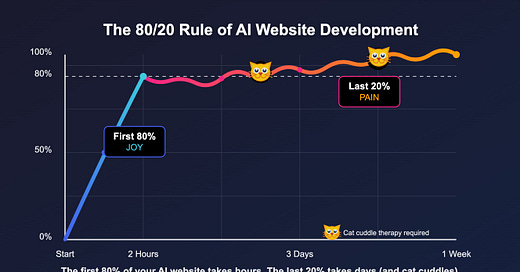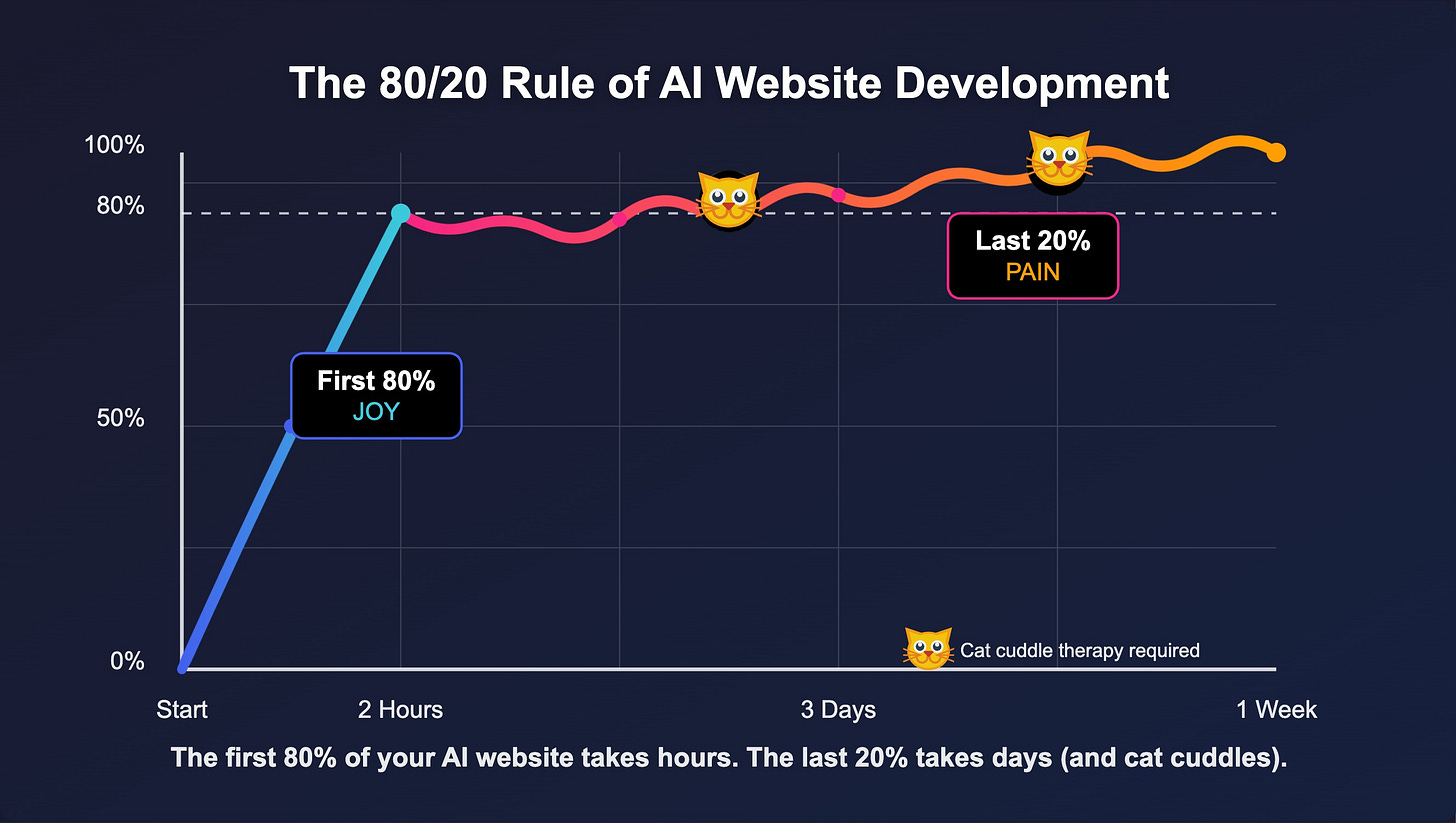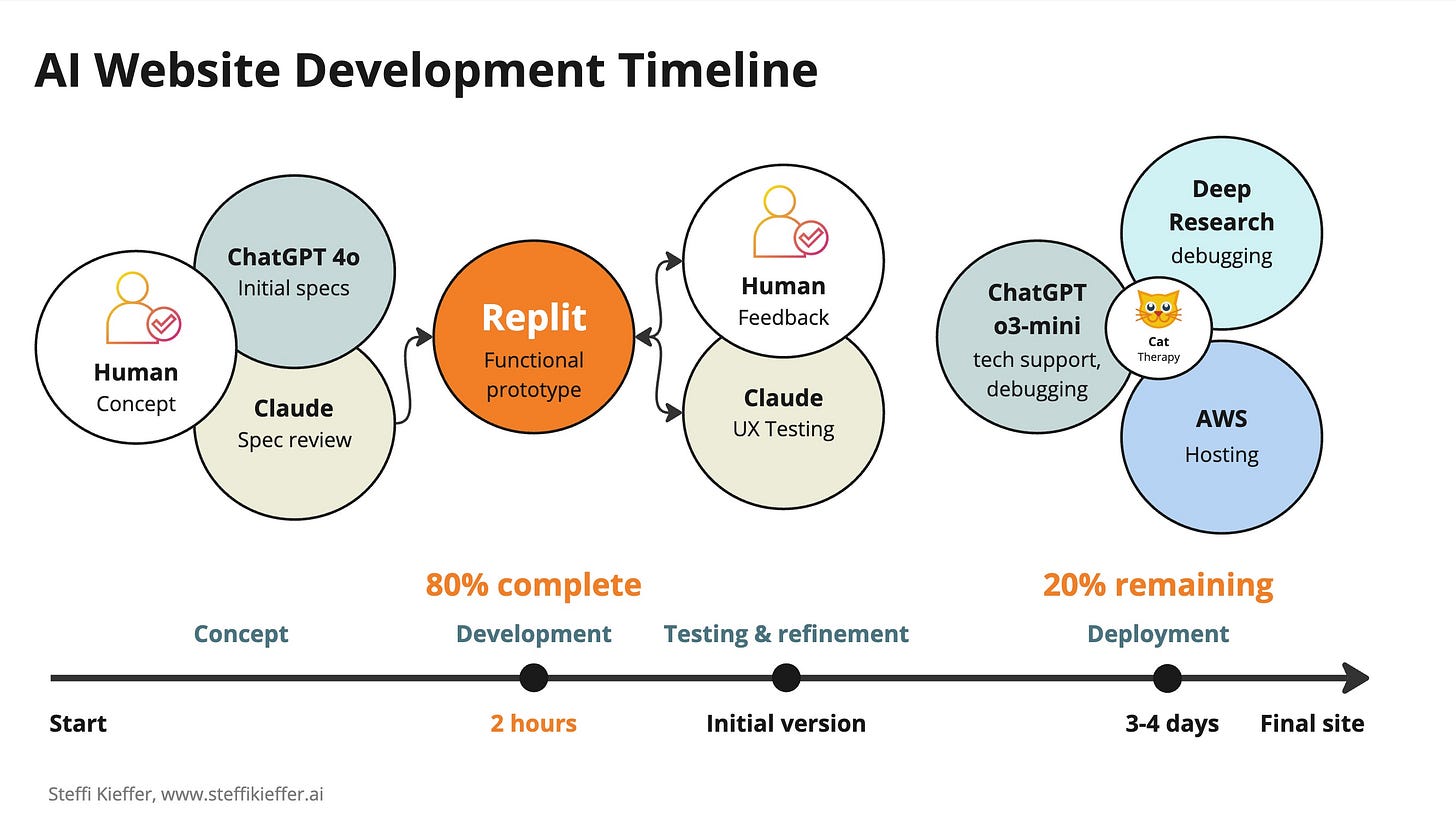The AI Website Chronicles: 80% Joy, 20% Pain
AI promised to democratize web development. "Anyone can build a website now!" they said. Well, they were right—sort of.
Is it possible for someone with decades of UX design experience but zero coding skills to build a functioning website using AI? Yes. Is it painless? Not quite.
I finally managed to publish my own website using AI—a significant achievement for someone who's always shied away from the technical side despite decades in the tech industry. As someone who helps teams use AI to augment human creativity, I wanted to experience firsthand what these tools can really do. The journey involved ChatGPT (4o and o3-mini), Claude, Replit, and ultimately AWS—a combination that proved both powerful and occasionally frustrating.
Replit: Text-to-UI AI tool
The 80/20 Rule in Full Effect
AI got me to the first 80% very fast—literally a couple of hours and I had a working draft.
The remaining 20%? A nightmare that took what seemed like an eternity.
The Tools & Approach
My approach was hardly revolutionary—pen and paper sketches, followed by AI-generated specs pasted into Replit. Why Replit? It felt intuitive. In retrospect, comparing development platforms might have saved headaches.
When you're eager to build rather than research, these snap decisions happen.
I got invaluable feedback from 3 humans on the first version I created. Human feedback remains irreplaceable, even in an AI-driven process.
What surprised me most was how Replit shortened the path from idea to working prototype. I could implement features, micro-interactions, and animations I would have never bothered with in static design tools like Figma. Rather than working with detailed mockups, I iterated directly in a live environment, immediately seeing what worked and what didn't. No more static designs, just instant working versions.
The Real Costs (Ouch!)
The Replit money score:
Agents: 196 checkpoints at $0.25 each = $49.00
Assistants: 23 edit requests at $0.05 each = $1.15
Total: $50.15 ($25 subscription + $25.15 overage)
I maxed out the free version almost instantly and opted for the $25 monthly subscription. Then hit the limits again. Classic.
Only later did I learn that Assistants are cheaper for small changes while Agents handle full features. Money lesson learned the hard way.
In Replit, I used the chat interface for most changes, often combined with screenshots. For simple text edits, I eventually skipped the chat and edited code directly.
For hosting, I ditched Replit's $20 monthly plan and moved to AWS for my simple landing page. Cheaper.
When the Fun Stopped: Technical Challenges
Getting files off Replit wasn't intuitive. Converting them into something AWS-compatible was even worse.
As a non-technical person, I had paid zero attention to the code being generated. React? Sure, whatever that means.
This migration phase would likely intimidate most non-developers. It certainly tested my patience.
AI Tool Showdown
Each AI had its specialty:
ChatGPT 4o: Great for initial specs and some debugging tasks
Claude: Excellent for initial spec-writing and getting AIs to critique each other's work
o3-mini: The problem-solver. Faster, clearer instructions for troubleshooting
Claude for debugging: Too overwhelming for a non-techie—probably perfect for experts
Claude for UX testing: Surprisingly effective! I assigned it roles like "tired PM on a crowded train" and had it critique screenshots in first-person
ChatGPT 4o: Handled most of the security certificate setup
"Deep Research" feature in ChatGPT: Saved me when my HTTPS site refused to work
The role-play approach with Claude was particularly valuable—I'd ask it to tell me what goes through its mind when seeing the site and where it would click. Then I'd manually navigate to that spot and paste the new screenshot back, creating a makeshift user test.
The Final Stretch
After navigating the AWS jungle and countless debugging sessions, the site is live.
Not perfect—just good enough for launch.
The process required some intense cuddle sessions with my cat to calm my nerves.
Would I do it again? Absolutely. I put something decent online without any human developer assistance in about a week—compared to potentially weeks of back-and-forth with a developer.
Is This Right For You?
This approach works if you:
Have design experience but limited coding knowledge
Need a simple to moderately complex website
Can handle technical frustration (and have a therapy cat)
Can budget about $50-100 for development plus hosting
Have a few days to devote to the project (mostly for troubleshooting)
The biggest advantage? Speed to feedback. You can get something into users' hands incredibly fast using Replit—no need to worry about hosting or deployment for initial testing.
Perhaps the most interesting part is that non-developers can now handle the entire design and prototyping process independently. The last 20% (deployment) remains the challenge—ideally handed off to a technical expert if you have one available. Not interested in learning AWS configurations? Find someone who enjoys that sort of thing.
The ability to rapidly iterate on a working prototype rather than static mockups changes the game completely. It's the difference between describing a meal and actually tasting it.
Lessons Learned
Have a clear plan and choose the right AI tool for the job. I built the airplane while jumping off the cliff.
Understand the cost structure—Assistants for small changes, Agents for complex features. Those seemingly innocent "yes" responses to Replit suggestions add up fast.
Check how easily you can export your files before committing to a platform. Not all development environments play nicely with external hosting.
Human feedback remains irreplaceable. Get real people to test your first version, even if it's just 3 friends providing quick input.
Iterate in a working environment rather than static designs. Implementing interactions directly in Replit gave me better results than endless mockups would have.
Get creative with AI tools. Using Claude for role-playing user tests (like "tired PM on a crowded train") produced surprisingly valuable UX insights.
Separate the fun 80% from the technical 20%. If deployment isn't your thing, find someone who actually enjoys configuring AWS certificates.
The AI revolution in development is real, but don't expect a smooth ride. The tools will get you 80% there impressively fast—it's that last 20% where you'll earn your battle scars.
Want to try this yourself? Start small. Pick a simple landing page, set aside a few hours, and see what Claude and ChatGPT can help you build in Replit. The initial results will appear in minutes, not days. You'll be amazed at what's possible—and you'll discover exactly where AI still needs your human touch.
Time to jump in!
View Steffi’s landingpage






